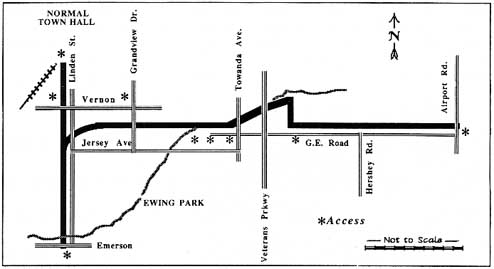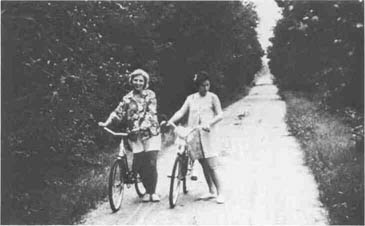 |
Home | Search | Browse | About IPO | Staff | Links |
 |
Home | Search | Browse | About IPO | Staff | Links |
|
������ Focus On Trails: ������
Linear Recreationways ��������������� By Dr. Robert Espeseth ��������������� Trails have always been an integral part of the development of resource-based park areas in the U.S., starting with the Adirondack Reservation in New York in the late 1800's, the early National and State parks and many of the large regional and urban park systems. These early trails or pathways were usually contained within the boundaries of the particular park property. One of the first exceptions to this philosophy was the development of the Appalachian Trail which runs from Mt. Katahdin in Maine to Mt. Oglethorpe in Georgia. This is a long trail which touches or toes through many state and national forests and parks, as well as across private land, and is truly a linear recreationway in its finest sense. Early parkway systems developed in New York, Chicago, Cleveland, Minneapolis and San Francisco (as examples) to take people in their carriages or "motor cars" from one major park or site to another along shady, landscaped extensions of the parks were also linear recreationways. The concept of linear recreationways is not new but the terminology is still not used very extensively. The focus on long trails over the past 25 years has brought increased attention to the concept of linear recreationways. Often these linear patterns have followed the rights-of-way (ROW) for railroads, canals, power lines, levees or followed the natural linear patterns of rivers, lakes, bluffs or ridges. Most of these linear patterns lend themselves best to trails for hiking, biking, horseback riding, snowmobiles, canoeing, boating and, in some cases, mini-bikes and all-terrain vehicles. The types of use permitted on the trails depend on the character, location, configuration, slope, water quality, soil type and other factors. There can often be multiple-use of the trail by different types of users at the same time or separated by season. Some types of trail uses are more compatible than others. The idea of multiple-use should be carefully studied as a part of the initial planning and evaluated periodically as the use of a trail increases. The Illinois Department of Conservation (IDOC) has been criticized in some circles for not being a stronger advocate and leader in converting more of the abandoned railroad lines to trails.
However, after the highly emotional and political fight that went on to get the Rock Island Trail in Peoria and Stark counties established, and the abrupt opposition to a trail of two tunnels along an abandoned railroad in northwest Illinois, reactions to the establishment of trails would leave anyone a little "gun shy." It is unfortunate that agricultural and other highly emotional interest groups have taken such non-objective stands in opposition to the use of ANY rights-of-way for trail or recreation use. Although it is generally agreed that not all ROW make good trails, each should be analyzed and an objective decision reached as to the quality and potential use of a trail segment. IDOC is a leader in the use of canals for trails. There isn't another state in the country that has the likes of the Illinois and Mississippi (Hennepin) Canal and the Illinois and Michigan Canal under state ownership. When these two linear corridors are connected they will almost reach across the entire state. Not only are they tremendous trail resources but they are also outstanding historical and cultural resources. Recognition of the value of these linear corridors is partially coming to fruition with the establishment of the Illinois and Michigan Canal National Heritage Corridor. This is a unique cooperative effort with the National Park Service and communities and counties along this linear greenway. The counties in northeastern Illinois have been the leaders in promoting and managing long trail systems. There have been some examples of trail development in other parts of Illinois, but not nearly as concentrated as the northeastern area. In several instances there has been inter-county cooperation to allow the trails to continue beyond county boundaries. Natural linear corridors do not stop at community, county, or state lines and neither do many of the man-made corridors. Therefore, it is often important to have a larger unit or agency of government, i.e. state or county, coordinating a trail plan; where gaps in local unit participation occur, the larger unit can act to maintain continuity. The Illinois Prairie Path is one of the state's earliest examples of using an abandoned inter-urban railroad line for linear recreation. The Prairie Path runs from Elmhurst in eastern DuPage County westward into Kane County where it ties in with the Fox River Trail. The Fox River Trail is a north-south trail long the Fox River which connects with trails in McHenry County and the Great Western Trail into DeKalb County. One can ride or hike about 40 miles from Elmhurst to Sycamore. Will County is also developing a long trail which will tie into Cook County and will potentially be a connector between the I & M Canal Trail and the Indiana state line. Cook County has many long trails in their Forest Preserve District and along the shoreline of Lake Michigan operated by the Chicago Park

The Vadalabene Trail along the Mississippi River between Alton and Grafton is a heavily used trail following the Illinois Route 100 highway corridor. Bloomington-Normal recently cooperated on a trail within their communities on an abandoned ROW. The asphalt-surfaced Constitution Trail is presently 4.4 miles long, but may be extended in a loop of about 8 more miles. An opportunity existed to connect up a trail out to Evergreen Lake, a major county recreation area, but state or county coordination was required. Mattoon and Charleston are currently involved in planning a trail about 12 miles long on an abandoned railroad ROW through and beween the two communities. Coles County is expected to cooperate in the project. Private sources can also be involved, such as the not-for-profit corporation, Heartland Pathways, which has acquired about 33 miles of abandoned railroad ROW in Central Illinois' Champaign and Piatt counties through private donations. This is a mechanism which has not been used as often to acquire ROW, but could be used to operate and maintain the trail after a state or county agency has acquired the ROW. In Wisconsin, several of the state-owned and developed trails have been leased out on a concession basis to nonprofit corporations. Most notable of the trails for which these arrangements have been made are the Elroy-Sparta Trail, the first of the linear trails in the state, and the Sugar River Trail just across the state line from Illinois. A recent study of the Elroy-Sparta Trail indicated that the 50,000 plus annual users spent about $1.3 million in the area and that nearly one-half of them traveled from out of state. (Wisconsin Recreation Resource Center - UWM.) A recently passed bill by the Illinois General Assembly, S.B. 787, makes approximately $5 million available for acquisition and development of bikeways. A portion of these funds will be for Department of Conservation-built trails and another portion for grants to local agencies. Governor Thompson signed the bill into law August 31, 1989. The Department of Conservation will administer the grants which become available sometime in 1990. The Rails-to-Trails Conservancy was established nationally a few years ago to provide an advocacy group for the conversion of abandoned railroad ROW to recreation trail use, to be a clearing house for information and to sponsor workshops and other educational opportunities. They have recently employed an Illinois coordinator and have many fine publications. You can join as an individual or

Bicyclists enjoy the railroad ROW
Trails: Linear Recreationways (Continued) ��������������� group by contacting them at 1400 16th Street, N.W., Washington, DC 20036. About fifteen years ago an Illinois Inter-Agency Bikeway Council was formed to take a comprehensive look at the needs and opportunities for bikeways in Illinois. Dale Hench (IDOC) served on the main Task Force and Bob Espeseth (University of Illinois) was on the Research and Survey Subcommittee. (Both are former directors of the Parks and Natural Resource Management Section of IPRA). The Council put together an excellent report, "A Comprehensive Bikeway Program", and submitted it to Governor Walker. Political parties changed and, through political machinations, nothing was ever done to implement any of the recommendations. Recently a work group for the Interagency Council has been meeting and is drafting a report for Council consideration. Allan Abbot, Illinois Department of Transportation, is Chair of the Council. Perhaps it is time to think in terms of a comprehensive state trail plan or program for Illinois which would provide direction for future efforts and funding for trails in the state. Some of the work done by the Bikeway Council could be the basis for such a plan. The State Comprehensive Outdoor Recreation Plan (SCORP) addressed trails to some degree at various times, but tended to be much broader in scope. It is time that we put more "Focus on Trails" in Illinois!
|
|
|